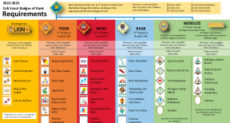 Update: On October 23, the BSA announced the new fees, as you’ve probably heard:
Update: On October 23, the BSA announced the new fees, as you’ve probably heard:
- Youth members in Cub Scouts, ScoutsBSA, Venturing and Sea Scouting, $60 per year
- Youth members in Exploring, $36 per year
- Adult members, $36 per year
- Annual charter fee, $60 per unit (previously $40)
More information and links in this post on the Scouting Magazine blog.
We now rejoin this post, already in progress.
By now you’ve heard about the Boy Scouts of America’s plans to increase the annual registration fee for youth and adult participants. The fee, currently $33 per year, is charged of all registered youth members and adults (with a few exceptions, such as Merit Badge Counselors, parent partners and such). Many councils add a local insurance fee to this, but the $33 goes to National. We’ve been told that it will be going up effective with charters that renew starting this fall. We are in suspense about the amount of the fee increase; it hasn’t been announced at press time, but the BSA has informed us that the increase will be considered and acted upon by the National Executive Board and conveyed to us no later than October 23.
Naturally, this announcement has landed like a ton of bricks with nearly every unit. Most troops, packs and crews plan an annual budget revolving around the fees they must charge in order to renew their charter and provide for program and operating expenses. Packs, especially, needed to have a dollar figure to tell new recruits that come into our program as the school year starts. Now, faced with an uncertain increase in their costs, units must make a decision on how to fit an as-yet-unannounced hike into their budget for the program year.
There is much speculation as the amount if the increase, which is being blamed on the national organization’s increasing costs for liability insurance. No doubt this increase in insurance costs is due at least in part to the lawsuits the organization faces as the result of the disclosure of allegations of sexual abuse by volunteers over the years and the handling of those allegations by the BSA. A Scouting colleague who is knowledgeable about insurance matters told me that the BSA can no longer be self-insured, due to the enormous settlements it has recently encountered and anticipates as yet to come, and because of these circumstances is looking at premiums for commercial liability insurance ranging in the tens of millions of dollars going forward. Divide this by roughly two million participants and you can see how much the cost of this liability insurance can be ascribed to each and every Scout and volunteer.
Whether this is fair to current participants – to have to atone for the sins of the organization several generations ago – is a valid question. Grassroots efforts in this regard are somewhat limited. The National Council is governed by local councils, which are in turn governed by the chartered organizations, and meaningful change will have to trickle upwards. “We the people” don’t have a direct say; we either follow the organization’s methods and processes, or we leave the organization. Realizing, however, that there is little that can be done about it in the near term, our efforts need to be centered on how to ensure that the Scouting program can continue for our families, and how we are going to pay for it.
As mentioned earlier, it puts our units in a tough spot. We don’t want to go back to our families, to whom we’ve already quoted an annual cost, that we need to charge more, but we don’t yet know how much that will be. Most unit leaders that I’ve talked to have decided to keep their fees at the previously-announced amount and make changes in other areas of their budget. Here are a few possibilities:
- Cut back on those things that are provided “for free” or included in membership as in the past. This could include having to charge extra for events like outings, Pinewood Derby, Blue & Gold Banquet, and camping.
- Likewise, packs and troops that included Boys’ Life (Scout Life in the future) are deciding not to automatically provide it, but to charge the extra $12 if anyone wants it.
- Reduce the number of insignia and awards given to Scouts. The Cub Scout belt loops cost $1.49 each, so by eliminating them, making them optional or charging for them could save $15 to $20 per year per Scout. Progress toward ranks used to be recognized with beads on a cord before the Adventure program came along, so something similar could be substituted at the unit level. Patches that Cub Scouts customarily receive for participating in activities and love to display on their red vests could be eliminated, parents could be asked to pay for them, or the cost can be included in the cost for the event or activity.
- Hold the line on fees but encourage more fundraising. Setting the bar higher for popcorn or other product sales could make up the difference, and units could reward additional sales with free camping or admission to pack or troop events.
- Rely on reserves, or use money that has been set aside for equipment (delaying purchases of tents and camping gear, for instance).
- Ask families for voluntary donations to keep the books balanced. We are not supposed to ask for donations, but if the parents are told about the situation, some may step up to help.
- And, if you decide to pass along the increase, you could possibly lessen the impact on families by allowing them to pay the increased fee in installments if you have the resources to delay collecting.
Once again, National has put us in an uncomfortable position. The last fee increase was from $24 to $33 per year, but was carried out at a time when most units could plan ahead for it. But with an increase that could very conceivably double the current cost, we are forced to make some fast decisions to make ends meet and keep as many youth in the program as we can.
Please comment below on how your unit plans to deal with the increase in registration fees.
New adult disclosure form: One other thing that we’ve been handed by National is a new adult background check disclosure and consent form. The new form must be completed by all adult volunteers, regardless of when they completed one previously, and must be turned in with the charter renewal this fall. The BSA intends to repeat background checks on all volunteers at regular intervals, and the new form facilitates this. Apparently the form that’s attached to the new adult application form didn’t meet the requirements stipulated by the BSA’s legal counsel, so the consent form was redesigned. A link to download the form was e-mailed to all registered volunteers with an e-mail address, but certainly more than a few didn’t receive it. You can download the form here. I recommend that committee chairs print and provide copies for their adults to sign. Note that it’s been expressly stipulated that the new form requires a “wet signature” – ink on paper – and electronic copies are not acceptable. And while Multiples (those registered in more than one unit) should only need to complete the form with their primary (paid) registration, it’s a good idea to turn one in to each unit in which they’re registered (including district and council positions when they recharter). Those who don’t turn one in will not have their membership renewed at recharter. Get ahead of this and get all of your adults to sign and return the new disclosure form as soon as possible, so you don’t run into defects and dropped members at recharter time.
Image: Pictures of Money / Creative Commons 2.0 license
This post first appeared on Bobwhite Blather.





Our Pack went up on Pack Dues and in Georgia the registration Fee is close to $50 per scout or volunteer leader. Our rounds ups this year have been the lowest in a while.
Regarding the new background check consent, I read the following in the authorization section: “…I consent to and authorize the Company to share this information with Company’s current or prospective clients, customers, others with a need to know, and/or their agents for business reasons (e.g., to place me in certain positions, work sites, etc.).” Who are the BSA’s current or prospective clients? This seems like a very broad statement that is not very clear. What am I giving up by signing this?
Some of your questions may be answered in an interview with the BSA’s general counsel in this blog post on Scouting Magazine’s website today. The post mentions that there’s a different disclosure and consent form for California Scouters, clarifies that only one form per Scouter is necessary, and there are instances where scans, faxes and electronic signatures can be accepted.
I understand about the fee increase. What sucks is the timing. How are troops/packs supposed to put together a budget? When Girl Scouts raised their membership dues the last time, it coincided with a new year. BSA are fools to not have this set, even if it’s a guess, because now we are going to have to go back and ask parents for additional funds, or do other options like you mentioned above… It’s extremely annoying.
We have had a few scouts tell us they aren’t continuing. (Our Pack charges $50 on joining night and then collect the rest in January). We also had a den leader and their child decide to leave. I am going to cough up the money since I am den leading and have to absorb the other dens scouts (whose leader just left) but I’m done after this school year. It’s gotten to the point where paying the dues and paying to volunteer just aren’t worth it. The money could pay for 5 sports programs or other experiences.